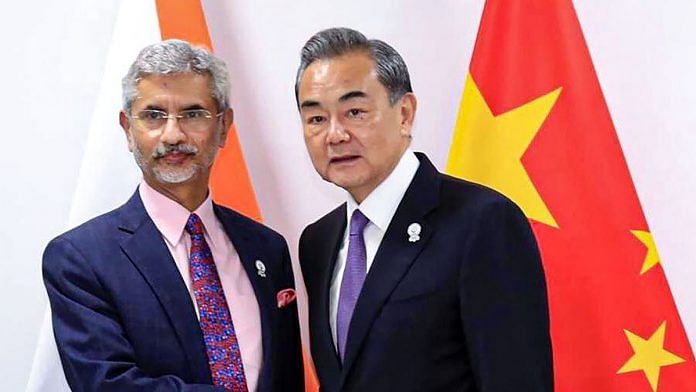New Delhi: India and China have decided to “expedite” work on a new set of confidence-building measures as soon as the ongoing standoff between forces in the Ladakh sector of the Line of Actual Control (LAC) eases, according to a joint statement issued after the meeting of External Affairs Minister S. Jaishankar and Chinese Foreign Minister Wang Yi.
Jaishankar and Chinese State Councilor Wang met Thursday evening in Moscow on the margins of the Shanghai Cooperation Council (SCO) foreign ministers meeting.
During the meeting that went on for nearly three hours, both sides agreed to “take guidance” from their respective leaders, Chinese President Xi Jinping and Prime Minister Narendra Modi, of “not allowing differences to become disputes” — an understanding that was reached during the last informal summit held between the two in Mamallapuram last year.
“The Ministers agreed that as the situation eases, the two sides should expedite work to conclude new Confidence Building Measures to maintain and enhance peace and tranquility in the border areas,” the joint statement said.
This comes at a time when both sides are discussing disengagement and de-escalation based on the five existing protocols that have been put in place over border management since 1993.
The pacts are the 1993 Agreement on Maintenance of Peace and Tranquility along the Line of Actual Control in the India-China Border Areas; the 1996 Agreement on Confidence Building Measures in the Military Field along the LAC; the 2005 Protocol on Modalities for the Implementation of the Confidence Building Measures in the Military Field along the LAC; the 2012 Agreement on the Establishment of a Working Mechanism for Consultation and Coordination on India-China Border Affairs; and 2013 Border Defence Cooperation Agreement.
Also read: India sits on Black Top with Helmet under its boots. A 1962 tactic by China is now likely
‘Continue dialogue, maintain proper distance’
Enumerating a five-point agenda on the easing of tensions, the joint statement said, “The two Foreign Ministers agreed that the current situation in the border areas is not in the interest of either side. They agreed therefore that the border troops of both sides should continue their dialogue, quickly disengage, maintain proper distance and ease tensions.”
According to Indian diplomatic sources, Jaishankar underlined during the meeting that since the resumption of ambassadorial-level relations in 1976 and holding of boundary talks since 1981, India-China relations have developed on a largely positive trajectory.
“While there have been incidents from time to time, peace and tranquility have largely prevailed in the border areas… As a result, India-China cooperation also developed in a broad range of domains, giving the relationship a more substantive character,” said a source.
India also informed China that the presence of such large concentration of troops was not in accordance with the 1993 and 1996 agreements and created “flash points” along the LAC.
The Chinese side didn’t provide a credible explanation for this deployment. The provocative behaviour of Chinese frontline troops in numerous incidents of friction along the LAC also showed disregard for bilateral agreements and protocols, said the sources.
They added that both sides agreed the “immediate task” is to ensure a comprehensive disengagement of troops in all the friction areas.
“That is necessary to prevent any untoward incident in the future. The final disposition of the troop deployment to their permanent posts and the phasing of the process is to be worked out by the military commanders,” the source said.
The Ministry of External Affairs confirmed Thursday that there will be a corps commander-level meeting between India and China soon.
Hours before Jaishankar and Wang’s meeting began, brigade commanders as well as commanding officers on the two sides held meetings to discuss tensions at Pangong Tso. In some areas at Pangong Tso, Indian and Chinese forces are less than 200 metres away.
Also read: Why Modi remains world’s most popular populist while Trump, Putin, Johnson struggle
Easing of border tensions prerequisite for business to resume
During the long conversation between the two ministers, New Delhi also made it clear to Beijing that unless the border tensions ease out completely normal bilateral ties between the two cannot resume.
“While the Indian side recognised that a solution to the boundary question required time and effort, it was also clear that the maintenance of peace and tranquility on the border areas was essential to the forward development of ties,” said the source quoted above.
“The recent incidents in eastern Ladakh, however, inevitably impacted the development of the bilateral relationship. Therefore, an urgent resolution of the current situation was in the interest of both nations,” the source said.
India said several times before since the standoff began in May that it cannot be business as usual with China unless temperatures in border areas cool down. However, in April the Modi government had made it difficult for Chinese investments to enter India, and banned a plethora of mobile applications run by China later in June.
What the Chinese embassy said
According to a statement issued by the Chinese embassy on the meeting, while Wang has agreed that it is normal for both neighbours to have differences, it is important “to put these differences in a proper context vis-à-vis bilateral relations”.
“Wang stressed that as two large developing countries emerging rapidly, what China and India need right now is cooperation and not confrontation, and mutual trust not suspicion,” according to the statement.
“Whenever the situation gets difficult, it is all the more important to ensure the stability of the overall relationship and preserve mutual trust,” it added.
Wang also agreed that the troops on both sides should “quickly disengage” in order to de-escalate the rising tensions. “The Indian side does not consider the development of India-China relations to be dependent on the settlement of the boundary question and India does not want to go backwards,” the statement claimed.
Also read: China wanted ‘no escalation’ on hotline call in the day, tried to capture territory at night



